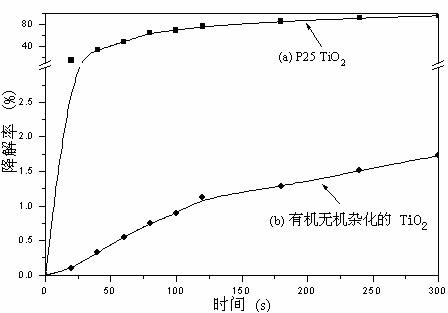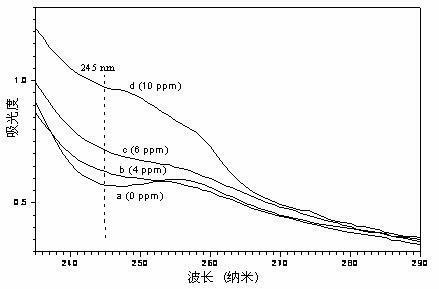Preparation method for organic-inorganic hybrid skin-friendly efficient sunscreen product
A friendly and inorganic technology, applied in skin care preparations, cosmetic preparations, cosmetics, etc., can solve problems such as skin damage, and achieve the effects of adjustable size, good dispersion and good sun protection effect.
- Summary
- Abstract
- Description
- Claims
- Application Information
AI Technical Summary
Problems solved by technology
Method used
Image
Examples
Embodiment 1
[0029] With polyethylene glycol monomethyl ether (PEO-Br) brominated at one end as the initiator, cuprous bromide (CuBr)
[0030] As a catalyst, PMDETA as a ligand, anhydrous methanol as a solvent, and dimethylaminoethyl methacrylate (DMA) with a molar ratio of 10:1 to the initiator as a monomer, under anhydrous and oxygen-free conditions at 30°C Atom Transfer Radical Polymerization to Obtain Diblock Polymer PEO 43 - b -PDMA 10 After 12 hours of reaction, the monomer styrene (Styrene) with a molar ratio of 80:1 to the macromolecular initiator was added to continue the reaction for 20 hours at a temperature of 110°C to obtain an amphiphilic triblock polymer PEO 43 - b -PDMA 10 - b -PS 80 .
[0031] PEO 43 - b -PDMA 10 - b -PS 80 The triblock polymer was dissolved in THF at a concentration of 50 mg / mL, and absolute ethanol was added dropwise for self-assembly, and the concentration of the polymer nanoparticle solution obtained after stirring for 50 h was 1 mg / mL. ...
Embodiment 2
[0036] PEO-DDMAT with azobisisobutyronitrile (AIBN) as the initiator and a molar ratio of 1:5 to the initiator
[0037] As a chain transfer agent, anhydrous tetrahydrofuran (THF) is used as a solvent, and dimethylaminoethyl methacrylate (DMA) with a molar ratio of 40:1 to the initiator is used as a monomer, at 70°C under anhydrous and oxygen-free conditions After 12 hours of reaction, styrene was dissolved in p-xylene and added to the reaction vessel to continue the reaction for 24 hours to obtain the amphiphilic triblock polymer PEO 43 - b -PDMA 40 - b -PS 30 .
[0038] PEO 43 - b -PDMA 40 - b -PS 30 The triblock polymer was dissolved in dichloromethane at a concentration of 30 mg / mL, absolute ethanol was added dropwise for self-assembly, and the concentration of polymer nanoparticles obtained after stirring for 50 h was 2 mg / mL.
[0039] Dissolve ethyl titanate in absolute ethanol at a concentration of 5 mg / mL, drop it into a solution of polymer nanoparticles...
Embodiment 3
[0041] With polyethylene glycol monomethyl ether (PEO-Br) brominated at one end as the initiator, cuprous bromide (CuBr)
[0042] As a catalyst, PMDETA as a ligand, anhydrous methanol as a solvent, and dimethylaminoethyl methacrylate (DMA) with a molar ratio of 60:1 to the initiator as a monomer, under anhydrous and oxygen-free conditions at 30°C Atom Transfer Radical Polymerization to Obtain Diblock Polymer PEO 43 - b -PDMA 60 , after the reaction was carried out for 8 hours, the monomer styrene with a molar ratio of 120:1 was added to the macroinitiator to continue the reaction for 20 hours, and the temperature was 110 ° C to obtain the amphiphilic triblock polymer PEO 43 - b -PDMA 60 - b -PS 120 .
[0043] PEO 43 - b -PDMA 60 - b -PS 120 The triblock polymer was dissolved in dimethylformamide (DMF) at a concentration of 10 mg / mL, and absolute ethanol was added dropwise for self-assembly, and the concentration of polymer nanoparticles obtained after stirring for...
PUM
| Property | Measurement | Unit |
|---|---|---|
| Concentration | aaaaa | aaaaa |
Abstract
Description
Claims
Application Information
 Login to View More
Login to View More - Generate Ideas
- Intellectual Property
- Life Sciences
- Materials
- Tech Scout
- Unparalleled Data Quality
- Higher Quality Content
- 60% Fewer Hallucinations
Browse by: Latest US Patents, China's latest patents, Technical Efficacy Thesaurus, Application Domain, Technology Topic, Popular Technical Reports.
© 2025 PatSnap. All rights reserved.Legal|Privacy policy|Modern Slavery Act Transparency Statement|Sitemap|About US| Contact US: help@patsnap.com



